Home Remedies to Clear Clogged Bathtubs Effectively


Intro
A clogged bathtub can feel like an unwanted guest that just won't leave. It's an annoyance that many homeowners face, often at the most inconvenient times. When the water doesn’t drain as it should, it can be both frustrating and a bit embarrassing, especially when guests are around. Thankfully, you don't need to rush out for chemical-laden solutions or hire an expensive plumber right away. There are effective home remedies that are not only easy to implement but also environmentally friendly.
With a little know-how and some readily available ingredients, you can tackle this unwelcome blockage. This article will guide you through various home remedies, discussing their efficiency, safety, and earthy impact. So grab your gloves, and let’s dive into some practical strategies that keep your bathroom functional and your peace of mind intact.
Common Causes of Clogged Bathtubs
Understanding the culprits behind a clogged bathtub can save you time and frustration in the long run. Here are a few key reasons why bathtubs get blocked:
- Hair Build-Up: A leading offender, hair can wrap around the drain and trap soap scum and other debris.
- Soap Scum: Over time, soap can create a sticky layer that attracts grime, further complicating drainage.
- Mineral Deposits: Hard water can cause minerals like calcium or magnesium to accumulate in your pipes.
- Foreign Objects: Sometimes, items that fall into the tub can create a blockage, leading to drainage issues.
Being aware of these common causes can help you implement preventive measures and act quickly when a clog occurs.
In the next sections, we'll explore practical home remedies that can clear those pesky clogs without resorting to toxic solutions.
Understanding Clogged Bathtubs
When it comes to keeping our homes in tip-top shape, clogged bathtubs can really throw a wrench in the works. Understanding clogs and their impacts on your bathing experience is essential. Not only do they disrupt your daily routine, but they can also lead to more significant plumbing issues down the road if not addressed promptly.
Bathtubs, as we know them, often contend with a build-up of hair, soap scum, and other debris. When these common contenders unite, they can create a nasty blockage, causing the water to drain slower than molasses or simply not at all. This can leave homeowners not only frustrated but also searching for quick remedies.
The good thing is, knowing the basics of bathtub clogs can save you both time and money. Several remedies for tackling these minor inconveniences are not only effective but also eco-friendly. With many solutions available, it’s essential to understand the common causes and the tell-tale signs that signal a problem.
As we venture deeper into this article, we’ll explore the nitty-gritty of bathtub clogs — from identifying what might be causing the blockage to the remedies at your disposal. We'll delve into safe and natural solutions that will bring back the bliss to your bathing experience, ensuring your sanctuary stays just that — a sanctuary.
Common Causes of Clogs
Clogs don’t just happen out of the blue; they lurk just beneath the surface, waiting for the right moment to disrupt your serenity. The primary suspects behind clogged bathtubs often include:
- Hair: The number one culprit. Loose strands tend to tangle and form stubborn masses.
- Soap Residue: Soap scum builds up over time, particularly in hard water areas where minerals combine.
- Bathroom Products: Items such as shampoo, conditioner, and body wash can also leave behind residue that contributes to clogs.
- Tiny Objects: Anything from a piece of jewelry to kids' toys can find their way down the drain.
Recognizing these factors can help you take preventive measures before a full-blown clog occurs. Make it a habit to periodically check and clean areas around the drain, keeping a keen eye for anything unusual.
Signs of a Clogged Bathtub
Spotting the signs of a clogged bathtub early on can save you a lot of hassle. Some of the indicators that your tub might be facing a blockage include:
- Slow Drainage: Water pooling around your ankles while bathing is a big red flag.
- Unpleasant Odors: Any foul smell emanating from the drain could signal a deeper problem requiring attention.
- Gurgling Sounds: Noise from the drain when water flows can indicate a build-up somewhere in the pipes.
- Backed-Up Water: If you've noticed water backing up into other fixtures (like sinks), that’s a surefire symptom of a clog needing urgent attention.
Being aware of these signs and taking action swiftly can mean the difference between a minor annoyance and a major plumbing headache. The faster you act, the better your chances are of resolving the situation before it gets out of hand.
"Ignoring the warning signs of a clog is akin to inviting trouble into your home; it's best to act swiftly to keep your bathing oasis intact."
Natural Chemical-Free Solutions
In recent years, homeowners have been leaning towards more eco-friendly practices. Natural chemical-free solutions not only address the issue of clogged bathtubs, but they also ensure safety for those using them, especially children and pets. The importance of these methods lies in their ability to tackle clogs effectively without introducing harmful toxins into the home, promoting a healthier living environment. Utilizing common household items like baking soda and vinegar or dish soap presents a practical approach that minimizes environmental impact while providing significant cost savings. These strategies resonate well with the growing demand for sustainable living, offering a holistic realm of home maintenance.
Baking Soda and Vinegar
How It Works
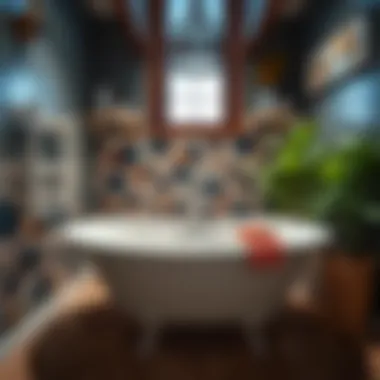

Baking soda, an alkaline substance, reacts with the acidic vinegar to create a fizzing effect. This reaction plays a crucial role in breaking down the debris and gunk lodged in the drain. As they mingle, carbon dioxide gas forms, forcing air and pressure through any gunk in its path. This unique characteristic makes the pairing a widely popular choice among homeowners looking for effective and non-toxic solutions. One major advantage is that this method is readily available in most kitchens, making it an easily accessible remedy.
Application Method
To utilize this method effectively, the application must be methodical. First, a half-cup of baking soda is poured down the drain, followed by a half-cup of vinegar. After sealing the drain with a stopper for about 30 minutes, hot water should be flushed through to clear the residue. This simple technique not only unclogs the drain, but it is also easy to perform, making it convenient for anyone. However, a downside is that if clogs are particularly stubborn or caused by significant blockages, this method may not achieve the desired results.
Effectiveness
The effectiveness of baking soda and vinegar as a remedy for clogged bathtubs is notable. It works best on minor clogs caused by soap residue or hair. Unlike harsh chemical cleaners, this approach does not impart any harmful residues and is safe for most plumbing systems. However, for recurring issues, relying solely on this method may prove ineffective. Homeowners may find themselves needing to combine solutions or resort to more intensive methods for persistent blockages.
Salt and Boiling Water
Steps to Use
A straightforward remedy, employing salt and boiling water requires minimal effort and ingredients. Start by heating a kettle full of water until it reaches a rolling boil. In a separate container, measure out about half a cup of salt. First, pour the salt down the drain. Then, immediately follow it with the boiling water. The high temperature helps dissolve any greasy clogs, while the salt works as a natural abrasive, aiding in the breakdown of blockages. This method is favored for its simplicity, but it demands vigilance to avoid scalding yourself with hot water.
Pros and Cons
Among the benefits, this hot combination is quick and can show results almost instantly. Boiling water, along with salt, works well in clearing minor to moderate clogs without chemicals. However, caution is warranted. If used excessively on certain types of pipes, boiling water might lead to damage, especially if there are plastic components involved. This method works best as a preventive measure or for less severe clogs.
Dish Soap and Hot Water
Mixing Instructions
Using dish soap in tandem with hot water presents a charmingly effective technique for battling clogs. To put this method into motion, squirt a liberal amount of any standard dish soap directly into the clogged drain, allowing it to settle for several minutes. Meanwhile, prepare hot water in a kettle or pot. Dish soap's unique characteristics break down greasy buildups, making it an intriguing remedy for those particularly sticky obstructions.
Timing and Expectations
Timing is essential here—allowing the soap to work its magic for about 10-15 minutes maximizes its effectiveness. Following this, pouring the hot water helps to flush the mixture through the drain, leaving a cleaner pathway. Although efficient, this method may not perform miracles on truly stubborn clogs, but it is an excellent first line of defense for greasy or oily residues, making it a favorite choice among those looking to maintain a clean and clear bathtub.
Mechanical Approaches to Unclogging
When dealing with a clogged bathtub, sometimes the natural remedies just don’t cut it. This is where mechanical approaches come in handy. They provide a more direct method for unclogging drains that might be stubborn or heavily blocked. Mechanical methods often involve tools that can reach deeper into the plumbing system to dislodge materials causing the blockage. These approaches can save time, prevent further damage to pipes, and keep the bathroom functional with minimal hassle.
Plunger Techniques
Types of Plungers
There are a variety of plungers tailored for different types of blockages. The most common types include the cup plunger, designed with a rubber cup on the end. This type is widely used for bathtubs because it generates suction effectively, providing a tight seal over the drain. On the other hand, the flange plunger, which has an extra flap extending from the cup, is ideal for toilets but can work on bathtubs too. The key characteristic of the cup plunger is its versatility and effectiveness in creating the pressure needed to dislodge clogs. While both plungers have their unique benefits, the cup is generally a more straightforward, familiar tool that many homeowners have on hand.
Proper Usage
Using a plunger correctly is essential for it to be effective. The technique involves filling the tub with a bit of water to allow the plunger to form a seal against the drain. The action of pushing and pulling the plunger creates suction that dislodges the clog. The beneficial aspect of this method is that it is quick and requires no additional tools or chemicals. However, if used improperly, it can lead to water splashing everywhere or even push the blockage further down the line, making it harder to resolve later. Therefore, understanding the right way to use a plunger can save both time and mess.
Using a Drain Snake
Choosing the Right Snake
When a plunger isn’t enough, a drain snake might be your best bet. These flexible tools can reach deep into the drain and remove blockages that are too far away for a typical household tool. A crucial advantage is the length and flexibility of these devices, which allows them to navigate curves and bends in the plumbing. There are manual hand-crank snakes and more robust electric snakes available. Choosing the right snake involves understanding the type of clog you are dealing with; heavier blockages may require a sturdier model. Knowing this can make a significant difference when trying to tackle stubborn clogs effectively.
Step-by-Step Guide
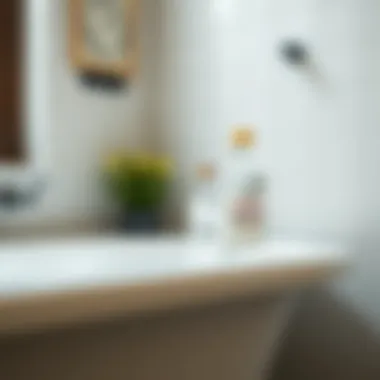
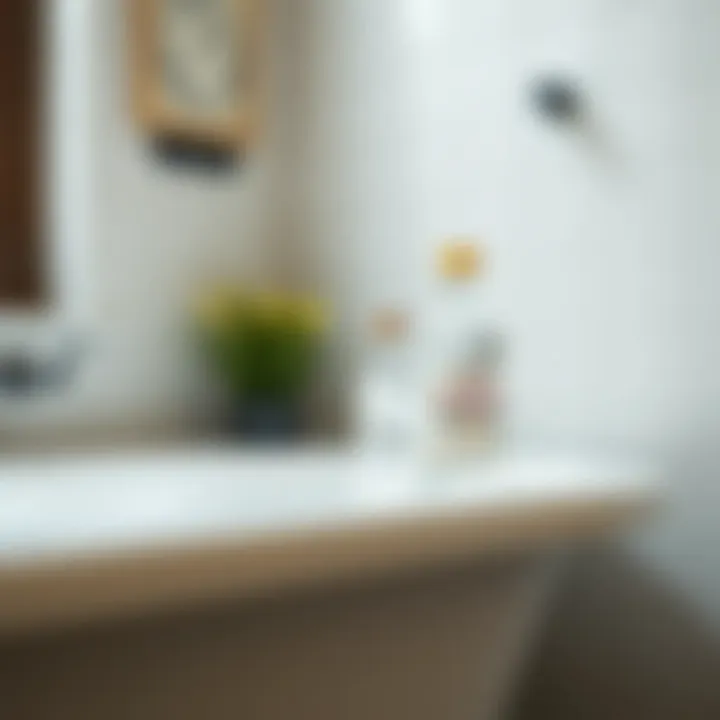
Using a drain snake may seem daunting, but it doesn't have to be. Start by inserting the snake into the drain. Rotate the handle to feed the snake deeper into the pipe. Once you hit a blockage, continue to rotate while applying gentle pressure. The key is patience; pull back on the snake occasionally to see if you’ve caught any debris. This step-by-step technique allows users to efficiently clear clogs while minimizing potential damage to their pipes. A significant benefit of this method is its comprehensive ability to tackle both minor aches and more serious obstructions. However, it does require some physical exertion and a bit of know-how.
Preventative Measures
Preventative measures play a crucial role in preserving the functionality of your bathtub, helping you sidestep the pesky problem of clogs altogether. By incorporating routine practices into your cleaning regimen, you can extend the life of your plumbing while keeping your bathroom an inviting escape. A little foresight goes a long way, and implementing these measures will prove beneficial not just for your immediate needs but also in maintaining your home's value over the years.
Regular Maintenance Practices
Cleaning Schedules
Establishing a cleaning schedule might seem trivial, yet it forms the backbone of an effective home maintenance strategy. Regularly dedicating time to clean your bathtub and its drain helps in catching potential issues before they escalate into significant repairs. The key characteristic of a cleaning schedule is its predictability; once you carve out a specific time each week or month, it becomes a part of your routine.
One unique feature of having a cleaning schedule is that it encourages consistency. Unlike the haphazard cleaning approach, where one might only address a problem as it arises, a fixed schedule allows you to stay one step ahead, preventing build-up and accumulation of hair, soap scum, and grime that leads to clogs. The advantage here is clear: you're not just reacting to problems but proactively keeping issues at bay. However, such a schedule also demands accountability. If not adhered to, it can lose its effectiveness. You must remain disciplined to see its benefits.
Products to Use
When it comes to maintaining a clear drain, the products you use can significantly influence your success. Non-toxic and eco-friendly cleaners are increasingly favored for daily use as they contribute to a healthier environment and prevent chemical build-up in your plumbing. The standout feature of using such products is that they are generally safer for both your family and the planet.
Incorporating baking soda or vinegar into your routine cleaning might sound almost too simple, yet these ingredients are exceptionally effective. They work to break down debris without the harsh impact of synthetic chemicals. Their unique properties allow them to gently clean while also preventing further blockages without causing harm. However, it’s important to note that not all products suit everyone’s needs. Some folks might prefer stronger solutions, while others gravitate toward the natural route. Understanding your cleaning preference is essential in determining the right products for you.
Using Drain Covers
By incorporating drain covers into your bathtub, you add a layer of prevention that can save you from untold headaches down the line. These simple tools catch hair and larger debris before they can jam your pipes. Particularly if you live in a household with multiple users, this measure can drastically cut down on clogs. It’s a straightforward yet effective strategy.
One notable advantage to using drain covers is their ease of use. They can typically be removed and cleaned without hassle, making them a low-maintenance solution. Some covers even have aesthetically pleasing designs, ensuring they fit seamlessly into your bathroom's decor. However, a downside to drain covers is that they require diligence in cleaning—if forgotten, they can also become sources of blockage. Regularly emptying them should be part of your cleaning routine to realize their full benefits.
"An ounce of prevention is worth a pound of cure."
In summary, integrating preventative measures into your household frameworks can significantly enhance your bathtub's functionality while ensuring a cleaner, more enjoyable bath experience. A little effort can save you from the frustration of unexpected clogs and the costs associated with professional intervention.
When to Seek Professional Help
Clogged bathtubs can be a nuisance, but sometimes, do-it-yourself remedies only go so far. When tackling stubborn clogs, knowing when to call a professional plumber can save you both time and money in the long run. The key factors to consider are the seriousness of the issue, your own ability to manage the problem, and the tools at your disposal.
A clog that keeps coming back no matter how many cleaning solutions or tools you've used? That's a clear signal that you need to seek outside help. Often, persistent drainage issues suggest problems deeper in your plumbing system—like tree roots infiltrating pipes or, worse yet, a total collapse of the pipeline.
Identifying Persistent Issues
If your bathtub is draining slowly or backing up frequently, these symptoms often point to a more complex issue than hair and soap scum buildup.
- Multiple Fixtures Affected: If multiple drains in your house are slow or clogged, you might be facing a broader plumbing problem, such as a main sewer line obstruction.
- Unpleasant Odors: Strange smells emanating from the drains could indicate stagnation or decaying material in the pipes. This is not just unpleasant—it could also pose health risks.
- Frequent Recurrence: The old adage states, "If it ain't broke, don’t fix it," but if you keep fixing and it breaks again, that's a problem!
Having your plumbing assessed by a professional ensures you’ll have peace of mind about your home's water system.
Hiring the Right Plumber
When it's time to get professional eyes on the job, not just any plumber will do. Selecting the right one can make all the difference in solving your plumbing woes.
Questions to Ask
Before hiring a plumber, consider asking a few pivotal questions:
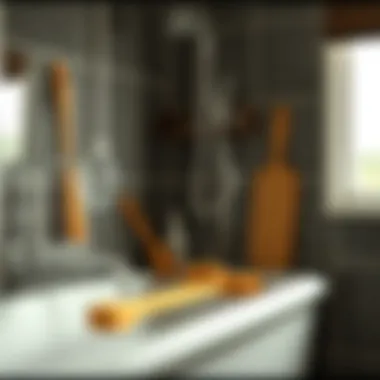
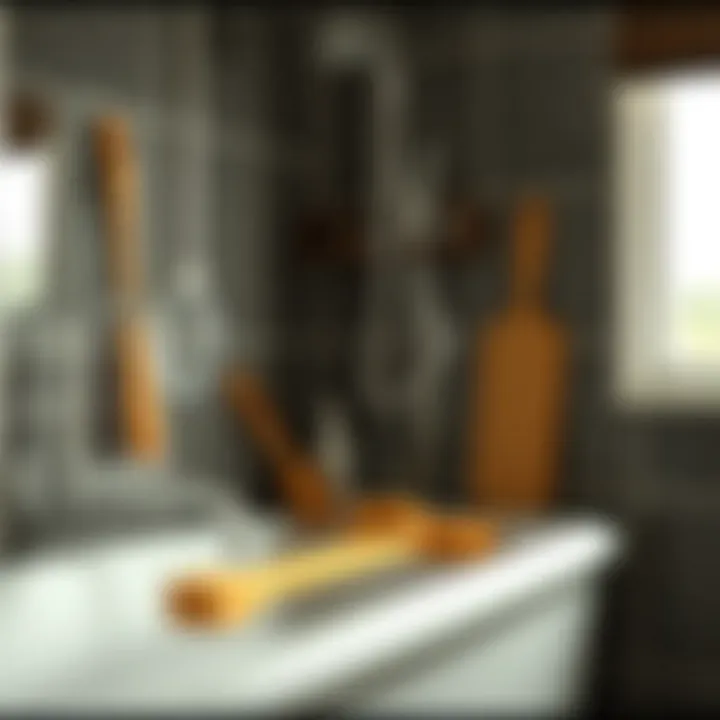
- Are you licensed and insured? This protects you from unforeseen issues during the repair work.
- What is your estimated time frame for repairs? Understanding how long the work might take is essential for planning.
- Can you provide references or reviews? Hearing from past customers can give you insights into their work ethic and reliability.
- What approach will you take for my specific issue? This allows you to gauge their experience and understand the process involved.
These inquiries set the stage for not only finding someone competent but also someone who values transparency and communication.
Estimated Costs
Understanding the financial aspects before diving in can prevent sticker shock later. Here are some considerations:
- Initial Assessment Fees: Many plumbers charge a fee simply to inspect the problem, so be clear on that front.
- Hourly Rates and Flat Fees: It’s vital to ask whether the plumber charges by the hour or offers flat rates for specific jobs. It can make a significant difference in costs.
- Replacement Parts and Labor: If your pipes need replacement, this can get pricey quickly. Therefore, make sure the plumber outlines all expected expenses so you can budget accordingly.
While you may initially hesitate at the thought of hiring a professional, the potential to save yourself from bigger problems in the future justifies the investment.
Remember: Your home is likely one of your biggest investments; don’t hesitate to put the right resources toward keeping it in tip-top shape.
Environmental Considerations
When tackling the issue of clogged bathtubs, it is imperative to consider the environmental ramifications of our cleaning techniques. As we look for solutions to our plumbing woes, it’s all too easy to reach for commercial drain cleaners that are packed with harsh chemicals. However, this article emphasizes the need for more eco-friendly approaches that are not only effective but also safeguard our planet.
Eco-Friendly Ingredients to Use
Utilizing eco-friendly ingredients offers multiple benefits. Not only do they reduce the risk of harming aquatic life, but they also foster a healthier indoor environment. Here are some ingredients you might want to keep in your cleaning arsenal:
- Baking Soda: This versatile power-house can help dislodge stubborn clogs. It’s non-toxic and safe for both children and pets.
- White Vinegar: Known for its acidic properties, vinegar can dissolve mineral deposits and grime without the toxic aftermath.
- Salt: An age-old remedy, especially when combined with hot water, salt can assist in breaking down clogs.
- Lemon Juice: The natural acidity can help in cutting through buildup while also leaving a fresh scent.
Using these ingredients not only prevents potential damage to your plumbing but also contributes to a more sustainable lifestyle.
By choosing eco-friendly remedies, individuals contribute to less water pollution and promote a healthier ecosystem. No single person can save the world, but we sure can make part of it a greener place one small step at a time.
Impact of Chemical Drain Cleaners
Chemical drain cleaners, while effective in the short term, can have long-lasting negative impacts on both our health and the environment. Here are some concerning aspects to consider:
- Toxic Fumes: Many commercial drain cleaners release harmful fumes that can irritate your lungs and eyes. Inhalation can pose risks, especially to vulnerable groups such as children or pets.
- Water Contamination: When these chemicals are washed down the drain, they can seep into water systems, contaminating rivers and lakes. This can have dire effects on wildlife.
- Pipe Damage: Over time, frequent use of aggressive chemicals could corrode your plumbing system. This might lead to more clogs in the long run, creating a cycle of dependency on chemical solutions.
The cumulative impact raises a red flag about the products we use. It is prudent to educate oneself on the potential risks and consider other avenues that do not compromise our health or that of our surroundings.
The End
Navigating the waters of home maintenance can often feel overwhelming, especially when it comes to plumbing issues such as clogged bathtubs. This article delves into effective remedies that are not just quick fixes, but sustainable solutions aimed at preserving the both functionality and integrity of your bathroom. The importance of tackling clog issues cannot be overstated; not only does it ensure your relaxation space serves its purpose, but it also prevents potential long-term damage to your plumbing system.
Summary of Effective Remedies
In reviewing the various methods discussed, it’s clear there are multiple avenues to address bathtub clogs effectively. Here’s a concise recap:
- Baking Soda and Vinegar: A classic duo that utilizes a chemical reaction to dislodge debris within the pipes. It’s simple, cost-effective, and notably kind to the environment.
- Salt and Boiling Water: This method takes advantage of hot temperature to dissolve grease and soap scum, ultimately pushing blockages further down the drain system.
- Dish Soap and Hot Water: Helpful for greasy buildups, this combination encourages a slippery solution, allowing clogs to flow rather than get stuck.
- Mechanical Solutions: Sometimes, you need to roll up your sleeves. Techniques like using a plunger or a drain snake allow for hands-on, immediate results when natural remedies fall short.
These remedies collectively form a robust approach to maintaining your bathtub’s efficiency without needing to resort to harsh chemical drain cleaners, which can harm plumbing and the environment.
Encouragement for Maintenance
Reflecting on the points raised throughout the article, it's evident that prevention is far easier than addressing a full-blown clog. Regular maintenance practices can greatly affect the longevity of your plumbing. Implementing small changes such as:
- Establishing a Cleaning Schedule: Dedicate time monthly to clean drains with natural solutions.
- Installing Drain Covers: Simple barriers can prevent hair and larger debris from entering the plumbing.
"An ounce of prevention is worth a pound of cure."
Taking these straightforward steps will help ensure your bathtub remains a peaceful retreat, rather than a site of frustration. By utilizing the remedies discussed and committing to ongoing care, you can sidestep the headaches associated with clogged bathtubs and preserve the quality of your sanctuary for years to come.



